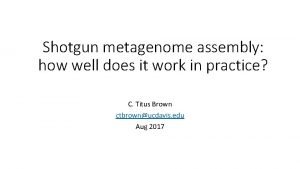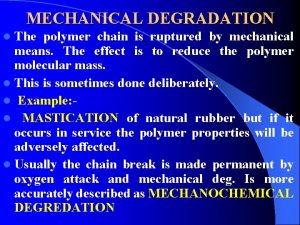Soil Metagenomics to Identify Indicators of Soil Degradation

- Slides: 1

Soil Metagenomics to Identify Indicators of Soil Degradation in the Bolivian Highlands Lorena Gomez, Ari 1 Jumpponen , Michael 1 Herman , and Karen A. Garrett Department of Plant Pathology and 1 Division of Biology, Kansas State University International collaborators include: Jorge Cusicanqui (U Mayor de San Andrés), Jere Gilles (U Missouri), Miguel Angel Gonzales (PROINPA), Elizabeth Jiménez (U de la Cordillera), Roberto Miranda (UMSA), Peter Motavalli (U Missouri), Corinne Valdivia (U Missouri), Abstract The Bolivian highlands (approximately 4000 masl) are experiencing changes in agricultural practices due in part to climate change and economic pressures. Traditional fallow periods are being shortened in an effort to increase yield, but this may be at the expense of soil quality. We will study soil microbial metagenomics using pyrosequencing methods, which allow us to place hundreds of thousands of individual microbes in taxonomic categories. Our goal is to identify microbes that may serve as indicators for the process of soil degradation and to understand the response of soil microbial communities to changing land management practices. Objectives 1. Characterize soil microbial communities from soils representing a range of levels of degradation 2. Identify microbial taxa that are indicators for levels of degradation, especially those that may indicate the process of degradation has begun but is still reversible 3. Link soil community structure to both the general soil biophysical context and the social science context in order to understand human impacts and drivers of human decision-making for soil management This work is funded by the USAID for the SANREM CRSP, Award No. EPP-A -00 -04 -00013 -00, to the OIRED at Virginia Tech. Methods • Ancoraimes, in the northern Altiplano, was selected as a study site for collection of soil samples. • We will identify the best sampling sites and sampling procedures to represent a range of soil degradation. • DNA will be extracted from each soil sample using Soil DNA Isolation Kits. • We will obtain the list of sequences corresponding to each sample using 454 sequencing. • Microbial community composition will be evaluated as a function of soil degradation. Anticipated results and significance • We will characterize the microbial community components that change with degree of soil degradation, learning which groups account for the largest changes with degradation. • We may identify soil pathogens. • Linking soil community and social science data will allow us to formulate better soil management practices. Photos c/o C. Valdivia and colleagues

